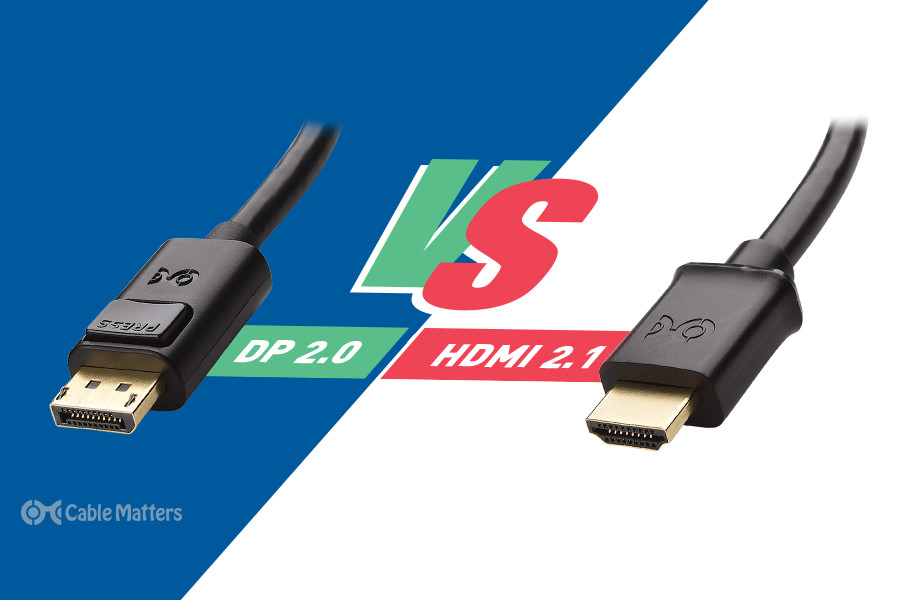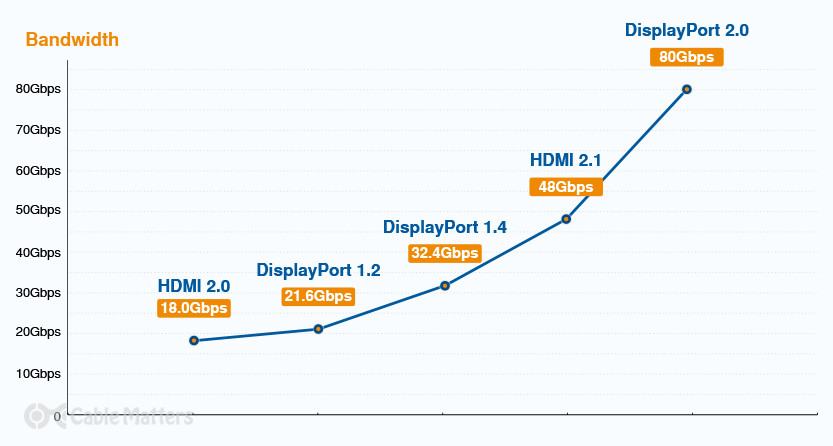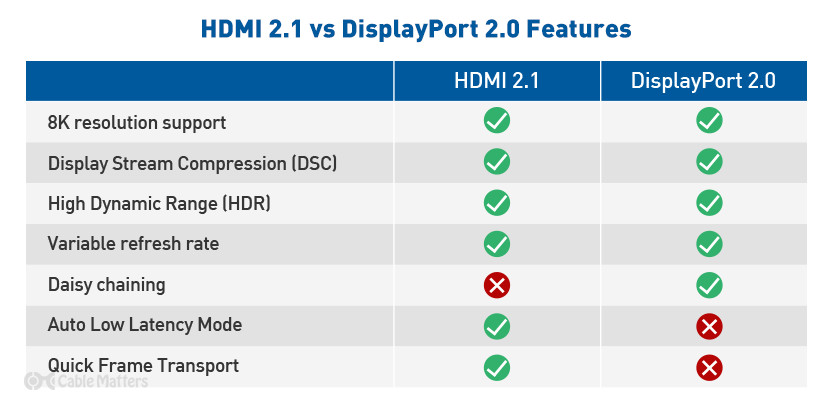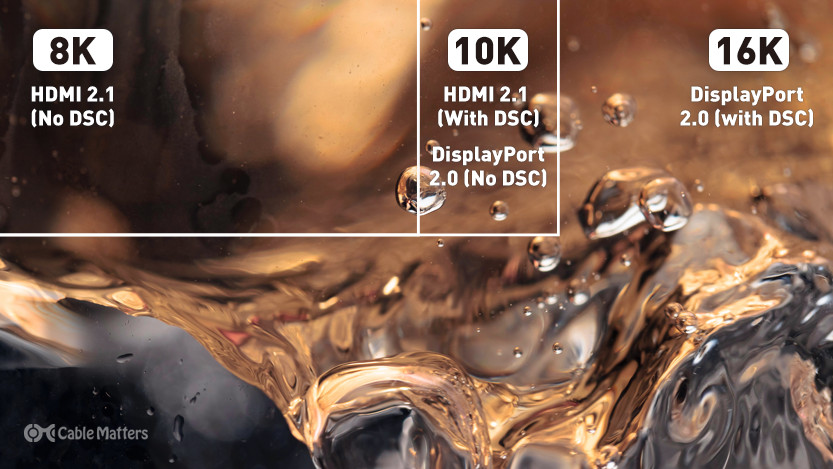
A new generation of cables is just cresting the horizon and it’s bringing with it more bandwidth, features, and capabilities than anything that’s come before. HDMI 2.1 cables are already a mainstay of new-generation console gaming, but DisplayPort 2.0 may not be too far away. When DisplayPort 2.0 arrives, it will enable a whole new theatre of high frame rates at ultra-high resolutions for high-end gaming PCs.
Like the HDMI 2.0 vs DisplayPort 1.4 debate that came before it, HDMI 2.1 vs. DisplayPort 2.0 will be the next great cable head-to-head.
HDMI 2.1 – The Best Right Now
HDMI 2.1 was a monumental leap in performance and features over its predecessors unlike any of the generational improvements that came before. Where HDMI 2.0 has a maximum bandwidth of just 18 Gbps, HDMI 2.1 can support as much as 48 Gbps. That enables support of higher resolutions at higher refresh rates, with and without HDR’s demands for additional color depth.
HDMI 2.1 can support 4K resolution at up to a previously impossible 144Hz, 4K resolution at 60Hz, and can even display 8K resolution at 60Hz. Display Stream Compression (DSC) lets it go further still, enabling 8K at 120Hz, or even 10K resolution at up to 100Hz, all without using chroma subsampling.
The HDMI 2.1 standard also brought with it a number of new features, including support for enhanced audio return channel, or eARC, where 5.1 and 7.1 surround sound data can be transmitted between an HDMI 2.1 source and a bespoke audio system over a single HDMI 2.1 cable. It also supports variable refresh rate and auto low latency mode for improved performance when gaming.
HDMI 2.1 cables are fully backward compatible with older HDMI standards, but they are necessary to enjoy the full bandwidth of HDMI 2.1. HDMI 2.0 cables can enjoy slightly increased bandwidth when connected to HDMI 2.1 connectors, but don’t come close to realizing the standard’s true potential
All of this makes HDMI 2.1 the best and most capable cable standard available today in 2022. Once DisplayPort 2.0 monitors and PCs start to appear though, it will be in for some stiff competition. In the desktop space, at least, HDMI 2.1 vs. DisplayPort 2.0 may not be much of a fight at all.
DisplayPort 2.0 – 8K Gaming and Beyond
If HDMI 2.1 is the gold standard for 4K gaming and ultra high-definition movies, DisplayPort 2.0 could be the cable that enables 8K gaming and more. It almost trebles the maximum data of DisplayPort 1.4 cables, and near-doubles that of HDMI 2.1, reaching as high as 80 Gbps.

This enormous bandwidth makes it possible for a DisplayPort 2.0 connection to handle 4K resolution at 240Hz, 5K at 180Hz, and even 8K at up to 85Hz – all without using DSC. HDR content reduces these maximums slightly, but it can still do 8K at 60Hz even with HDR enabled.
As much as 8K is a new standard with very little compatible content or displays to enjoy it on just yet, it will likely become a more mainstream standard in the years to come. When that happens, there won’t be any questions about which cable you’ll use. For HDMI 2.1 vs. DisplayPort 2.0; DP 2.0 is the obvious choice.
That extreme bandwidth also unlocks much higher resolutions: twin 4K displays at 144Hz with no compression, a 10K display at 60Hz with no compression, and even a 16K display at 60Hz with HDR when DSC is enabled.
Although these resolutions aren’t even on the horizon for traditional TVs, there is the potential for this sort of extreme resolution for virtual and augmented reality displays – even if no graphics cards exist as of yet that could meet such high frame rate and resolution demands.
As with previous generations of DisplayPort technology, it will also be possible to leverage DisplayPort 2.0 in DisplayPort Alt Mode using alternative connectors like USB-C and Thunderbolt.
There is no eARC-like support with DisplayPort 2.0, and it doesn’t have a big feature overhaul compared to its predecessors, but one new feature it does enjoy is Panel Replay. That helps optimize the power and thermal demands of connected devices so that they are only forced to render the portion of the screen that has changed since the previous frame. This is targeted at saving power in smaller connected devices like all-in-one PCs and laptops, but there is potential for a slight performance uplift for all devices that make use of it, too.

HDMI 2.1 vs DisplayPort 2.0 in 2022
The big downside to DisplayPort 2.0 in 2022, is that it’s not widely available yet. Not on devices, not on displays, and not in cable form. VESA has suggested it could start showing up before the end of the year, though. For now, HDMI 2.1 is much more readily available and is very much viable as a solution for all sorts of high-end media and gaming needs.

When DisplayPort 2.0 does arrive, expect it to be on desktop PCs and premium displays, before proliferating more widely in the years to come. You can also expect it to appear in business markets for ultra-high resolution displays in conference rooms and advertising systems.
What's next for DisplayPort vs HDMI?
On October 17, 2022, VESA announced that it has released the specifications for DisplayPort 2.1 and that this latest standard of DisplayPort is going to add significant improvements to DisplayPort tunneling over USB4 along with a few other key features, like DisplayPort bandwidth management which further increases the efficiency of the video data stream. What does this mean?
VESA appears to be steering the future of DisplayPort technology into coexisting seamlessly with USB4. All devices which currently are certified DisplayPort 2.0 already meet DisplayPort 2.1 specs. This means that all USB4 cables and devices, which previously supported DisplayPort 2.0, now support DisplayPort 2.1. With this new standard, VESA also mandates support for Display Stream Compression (DSC) and Panel Replay. Due to these improvements, the convenience, and the performance that USB4 and DisplayPort will offer, the question of DisplayPort 2.0 vs HDMI 2.1 has a clear, albeit unexpected, winner: DisplayPort 2.1.